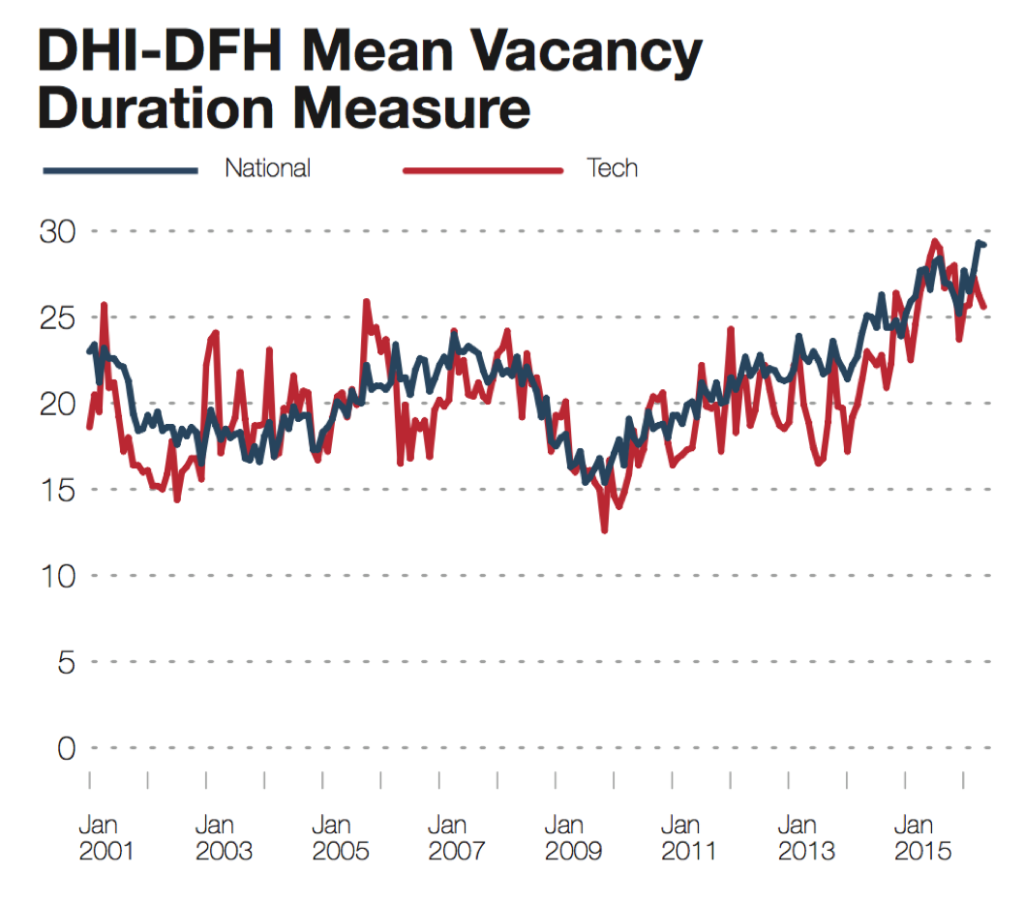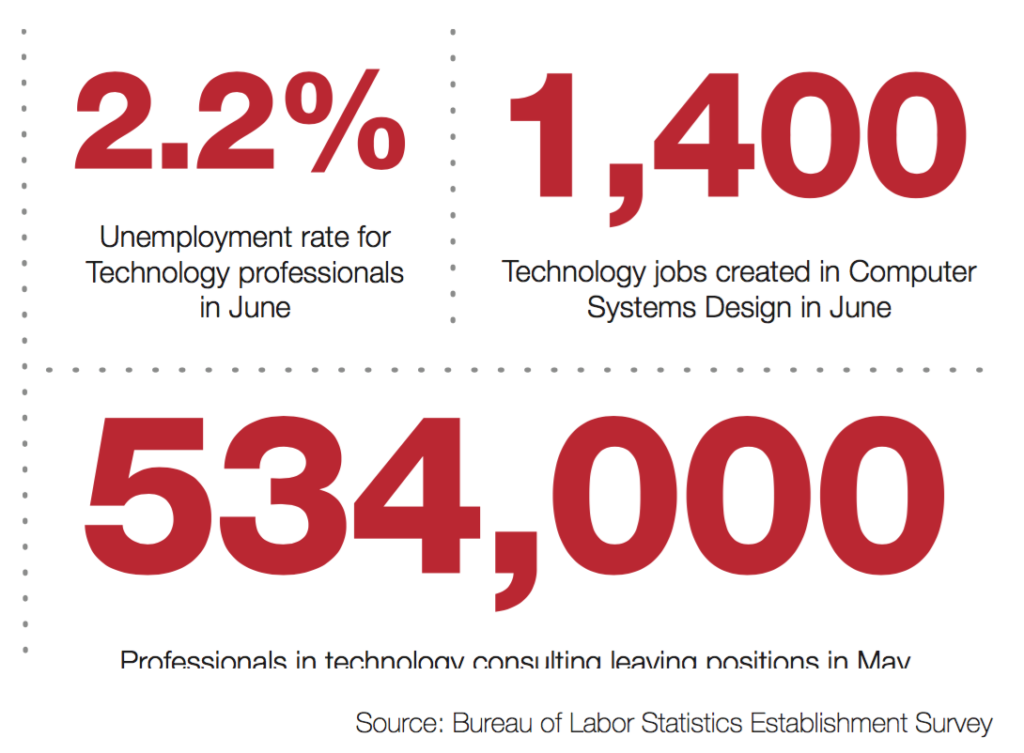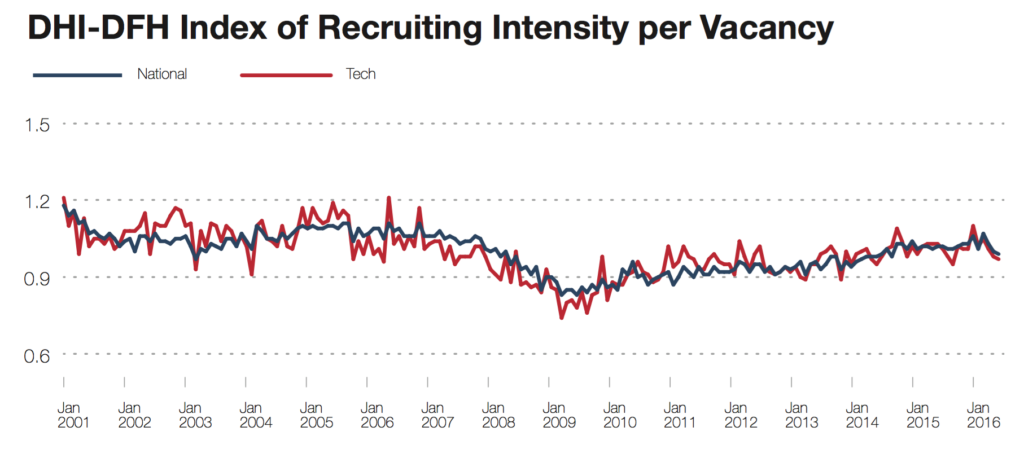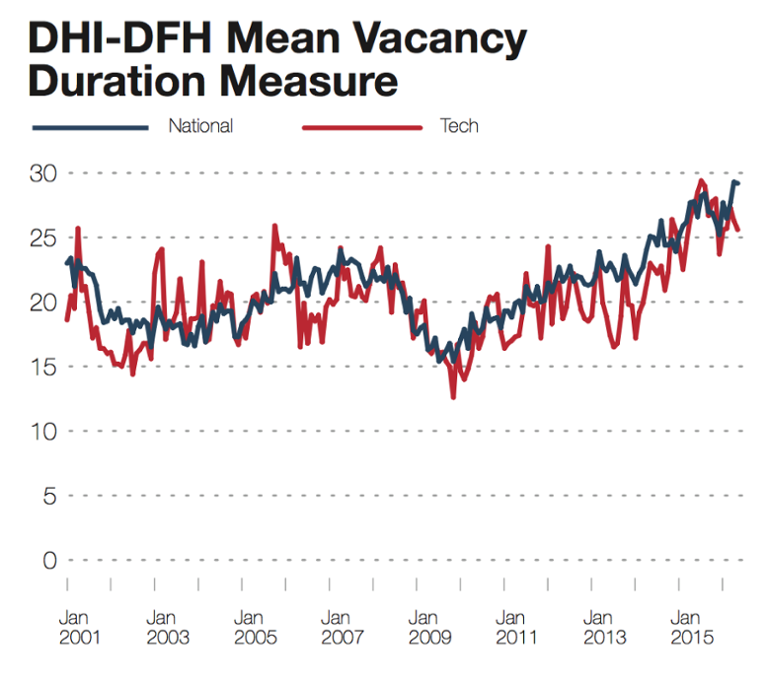
The DHI-DFH Mean Vacancy Duration measure found the average job vacancy duration of Professional
and Business Services jobs to be 26.1 working days in 2016. In May, technology jobs remained open for 25.6 working days, down from a revised 26.3 days in April. This is slightly below the national average of 29.2 working days. “Employers tell us sourcing for
highly skilled candidates is a priority, however finding top talent continues to be difficult, which is extending
the hiring process and lengthening the time-to-fill open positions,” said Michael Durney, President and CEO of DHI Group, Inc. “There is a level of economic uncertainty globally having an impact on hiring managers here in the U.S. Companies continue to hire, albeit at a slower pace than last year.”

Meanwhile, the DHI-DFH Recruiting
Intensity index saw the intensity of
companies to fill tech jobs dip to 0.97 in May from 0.98 in April. This recruiting intensity includes actions by employers to fill a job, including payments on help wanted ads, certain recruiting methods, applicant screening process, hiring standards and the attractiveness of compensation packages offered to prospective new hires. “Customers tell us they continue to have difficulty filling many key tech roles including software engineers, project managers, business analysts, .NET and
Java developers, all of which are frequently requested on Dice,” said Bob Melk, President of Dice. “There are costs and impact associated with employee turnover and the onboarding of a new one that significantly slow down projects, delay releases and can cause a company to fall behind competitively.”

About
The
DHI Hiring Indicators offer labor market insights from career provider
DHI Group, Inc. and Dr. Steven Davis, William H. Abbott Professor of International Business and Economics at the University Of Chicago Booth School Of Business and a Visiting Fellow at the Hoover Institution. The DHI-DFH vacancy duration measure reflects the vacancy concept in the Job Openings and Labor Turnover Survey (JOLTS) in the United States. Specifically, a job opening gets “filled” according to JOLTS when a job offer for the open position is accepted. So the vacancy duration statistics refer to the average length of time required to fill open positions. Typically, there is also a lag between the fill date and the new hire’s start date on the new job. The Indicators include a monthly report and data release to help employers, professionals and decision makers deepen their understanding of current workforce trends. The category of Professional and Business Services includes professional, scientific and technical activities for others. The category of Computer Systems Design and Related Services rolls into this.

 The DHI-DFH Mean Vacancy Duration measure found the average job vacancy duration of Professional
and Business Services jobs to be 26.1 working days in 2016. In May, technology jobs remained open for 25.6 working days, down from a revised 26.3 days in April. This is slightly below the national average of 29.2 working days. “Employers tell us sourcing for
highly skilled candidates is a priority, however finding top talent continues to be difficult, which is extending
the hiring process and lengthening the time-to-fill open positions,” said Michael Durney, President and CEO of DHI Group, Inc. “There is a level of economic uncertainty globally having an impact on hiring managers here in the U.S. Companies continue to hire, albeit at a slower pace than last year.”
The DHI-DFH Mean Vacancy Duration measure found the average job vacancy duration of Professional
and Business Services jobs to be 26.1 working days in 2016. In May, technology jobs remained open for 25.6 working days, down from a revised 26.3 days in April. This is slightly below the national average of 29.2 working days. “Employers tell us sourcing for
highly skilled candidates is a priority, however finding top talent continues to be difficult, which is extending
the hiring process and lengthening the time-to-fill open positions,” said Michael Durney, President and CEO of DHI Group, Inc. “There is a level of economic uncertainty globally having an impact on hiring managers here in the U.S. Companies continue to hire, albeit at a slower pace than last year.”  Meanwhile, the DHI-DFH Recruiting
Intensity index saw the intensity of
companies to fill tech jobs dip to 0.97 in May from 0.98 in April. This recruiting intensity includes actions by employers to fill a job, including payments on help wanted ads, certain recruiting methods, applicant screening process, hiring standards and the attractiveness of compensation packages offered to prospective new hires. “Customers tell us they continue to have difficulty filling many key tech roles including software engineers, project managers, business analysts, .NET and
Java developers, all of which are frequently requested on Dice,” said Bob Melk, President of Dice. “There are costs and impact associated with employee turnover and the onboarding of a new one that significantly slow down projects, delay releases and can cause a company to fall behind competitively.”
Meanwhile, the DHI-DFH Recruiting
Intensity index saw the intensity of
companies to fill tech jobs dip to 0.97 in May from 0.98 in April. This recruiting intensity includes actions by employers to fill a job, including payments on help wanted ads, certain recruiting methods, applicant screening process, hiring standards and the attractiveness of compensation packages offered to prospective new hires. “Customers tell us they continue to have difficulty filling many key tech roles including software engineers, project managers, business analysts, .NET and
Java developers, all of which are frequently requested on Dice,” said Bob Melk, President of Dice. “There are costs and impact associated with employee turnover and the onboarding of a new one that significantly slow down projects, delay releases and can cause a company to fall behind competitively.” 


